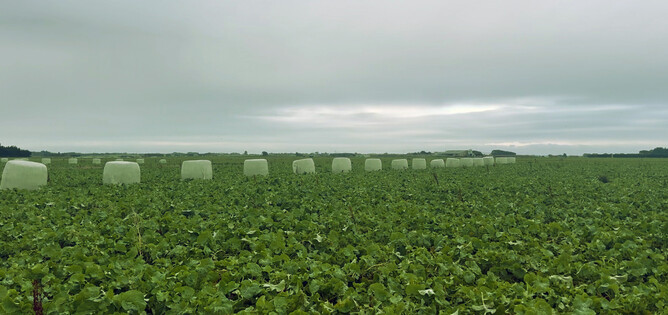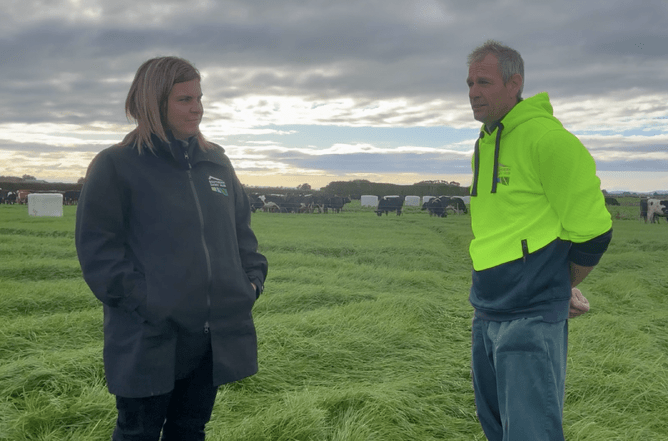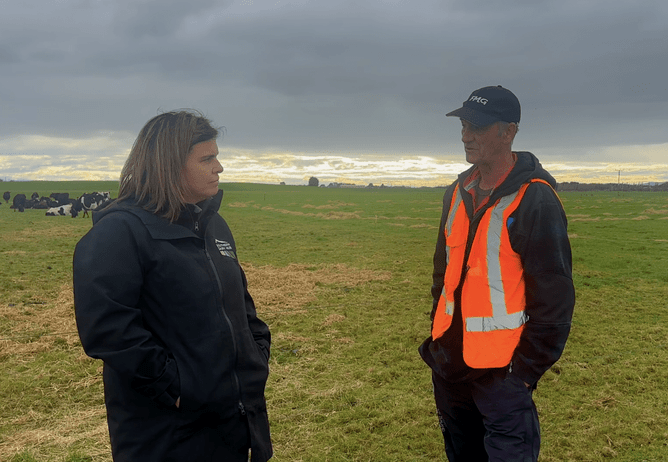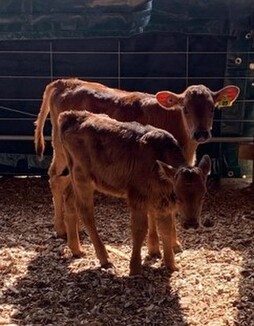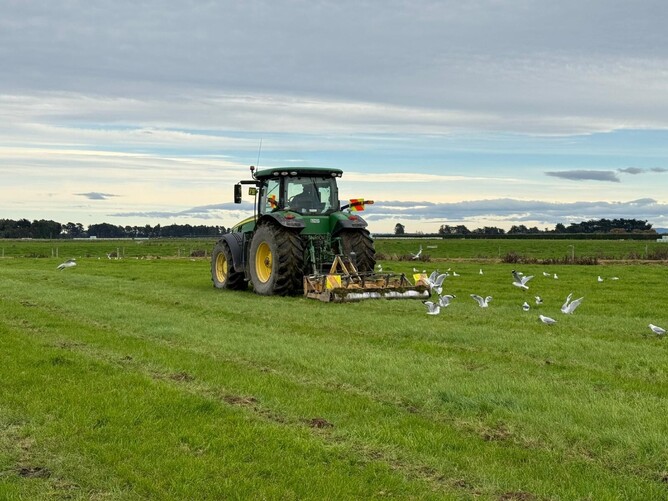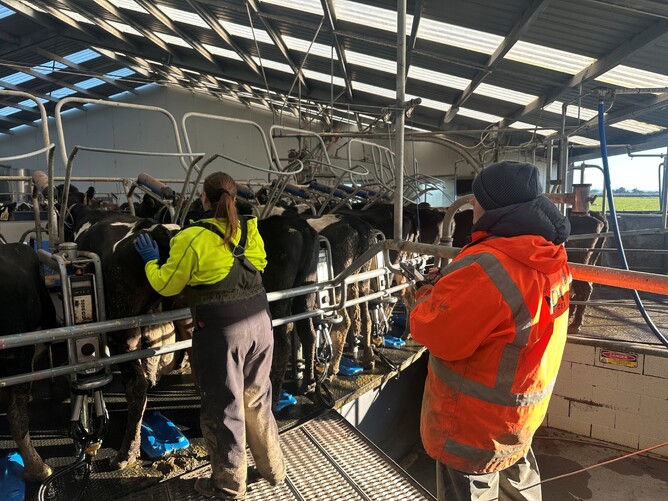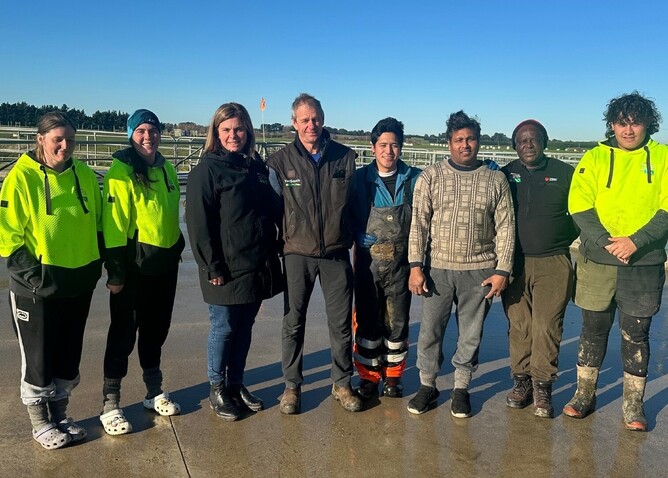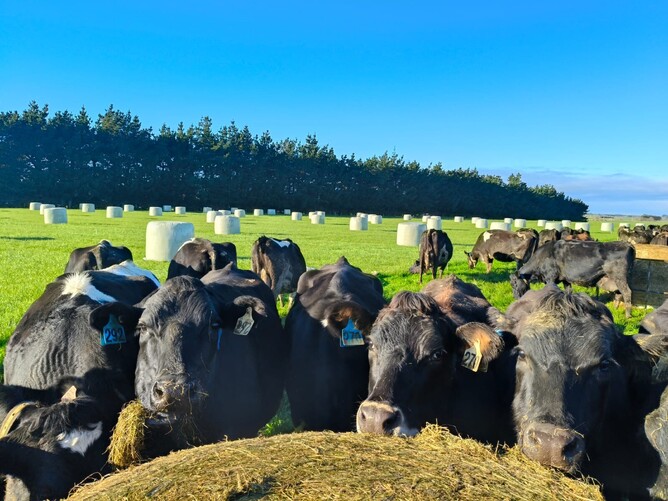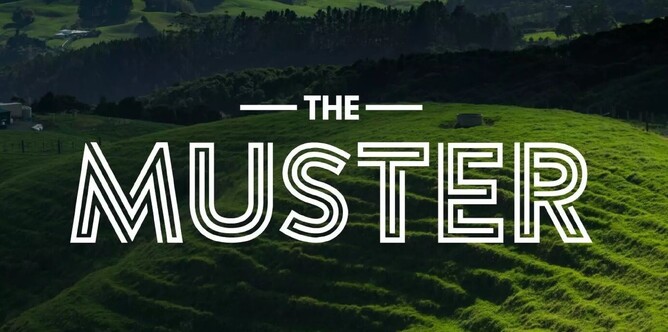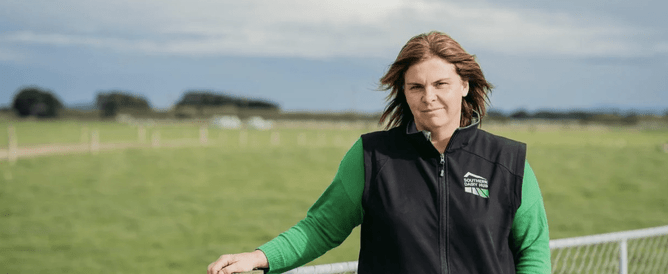Welcome to the latest edition of our newsletter. With winter well underway, the Southern Dairy Hub team has wrapped up the dry-off process and turned our focus to wintering, pasture management and ongoing research.
There are a few great reads in this newsletter, plus a few practical insights you can take back to the farm. As always, we’re very excited to share an update on our Future Farm Systems Demonstration Trial, comparing our Future Herd (focused on individual cow performance at lower stocking rates) with our Standard Herd (reflecting typical southern South Island farming practices).
You can keep up with what we’re learning through HubWatch at www.southerndairyhub.co.nz/hubwatch. Happy reading!
Andrea Dixon, SDH General Manager
On the Ground at the Hub
Here’s a quick update on what we’ve been up to since our last catch-up in May.
Farm manager Michael Berkers, farm supervisor Richard Jones and GM Andrea Dixon recently looked back at the key steps taken as we headed into winter, from feed planning and cow condition to soil recovery and paddock variation. It’s a good reminder of how flexible systems help keep cows healthy, protect pastures, and support our research.
Both the Standard and Future herds were dried off by late May, with decisions based on body condition scores (BCS). Around 60 cows were dried off early to allow them time to regain condition. Careful management of the final mobs ensured both animal welfare and research needs were met.
Standard cows are wintering on swedes and baleage, while the Future herd is on baleage and grass. One swede paddock was set up for 60 cows, while other mobs of 115 cows are wintered with feed allocated at around 14kg DM/cow/day. A central buffer zone provides a dry lying area during wet weather - a helpful mitigation as we assess soil and cow comfort impacts.
Swede yields varied this year, with some paddocks reaching 15–16 t DM/ha and others, like paddock 8, dropping below 11 t DM/ha. Supplementary baleage has kept feed plans on track. Cows were wintered in BCS-based mobs throughout June, before being redrafted into springer mobs in July to match feed and care to calving needs.
As part of our research, we’re comparing two wintering densities (67 vs. 44 bales/ha) to study effects on pugging, soil health and pasture performance. These paddocks were sown in Italian ryegrass for bulk winter feed and will be regrassed in spring.
We also continued remedial work in paddocks affected by last spring’s wet conditions. Late-autumn aeration has already shown promising signs of recovery, helping improve drainage and root depth after a season marked by shallow rooting and dry stress.
Looking back, our late-lactation switch to 3-in-2 milking boosted May production and reduced lameness. Dry-off was handled with care, tapering off feed while keeping cows healthy and comfortable.
As we move through winter, our focus is on monitoring performance and getting ready for calving.
Impact of Maternal Winter Diet on Calf Stature and Bone Morphology
By Dawn Dalley, DairyNZ
Research conducted by DairyNZ and Massey University at SDH over the 2019, 2020 and 2021 seasons looked at the impact of wintering diet on calves in utero. The study compared two herds of pregnant cows fed winter diets of either fodder beet or kale in conjunction with pasture baleage.
The researchers found calves born to dams on fodder beet were shorter in height and crown rump length, and despite variation in the stature and bone measures between years, the overall trend was for reduced bone density and strength in the calves born to fodder beet dams compared with those from the kale-fed mob.
Variation in results between years could indicate a year effect on the magnitude of the diet effect. This may be related to the timing of the feeding of the diets (duration and timing during foetal development), the magnitude of exposure (quantity of feed) or the composition of the diet (for example, protein, phosphorus content).
To determine the long-term impact of dam undernutrition on calf growth the researchers undertook a follow-up study looking at whether the effects of intrauterine growth retardation on bone morphology could be overcome by the time the animal reached its first lactation if adequate nutrition was supplied.
Additional heifers from each of the kale and fodder beet treatments in the first study were followed through to their first lactation (around 2.2 years old). All heifers were grown, mated, calved and milked together under standard farm practice. They were all wintered on pasture and baleage as rising one-year olds and on kale and pasture baleage as rising two-year olds. At least two weeks before calving they were removed from the kale diet and offered pasture and baleage before moving to the calving pad with self-fed silage, hay and straw ten days before expected calving date.
Bone samples taken of the heifers’ humerus approximately 10 weeks post calving indicated that humeral bone size, density, and strength were all normal. This result suggests that if adequate nutrition is supplied to the calf after birth, the intrauterine effects of dam diet on bone morphology may be overcome.
However, this conclusion may only be applicable to the duration and intensity of the dam’s nutritional challenges experienced in this trial and the feeding conditions of the calves between birth and calving. It is important to note that the animals were managed and sampled under commercial conditions which did impose logistical constraints that should be considered when interpreting the results.
Additional research is required to determine whether the lack of differences in bone morphology at two years of age truly reflects the ability of bone to overcome the intrauterine effects of dam diet.
To minimise the risk of intrauterine impacts on bone morphology of calves it is recommended farmers analyse their crops (leaf and bulb separately for fodder beet and swedes) and supplementary feed prior to feeding and formulate winter diets to ensure nutrient requirements are being met, rather than just allocating winter feed on a dry matter basis. The DairyNZ FeedChecker calculator is a useful tool that farmers can use to estimate the diet on offer relative to cow nutritional requirements.
References:
Gibson, MJ, Rogers, CW, Back, PJ, Dittmer, KE, Wherle-Martinez, A, Dalley, DE, Woods, RR. 2024. Can the effects of intrauterine growth retardation on bone morphology be overcome by first calving? - A preliminary study. New Zealand Journal of Animal Science and Production 84:26-29.
Gibson, MJ, Rogers, CW, Back, PJ, Dittmer, KE, Wherle-Martinez, A, Dalley, DE, Woods, RR. 2024. The intrauterine effects of a maternal winter diet of either kale or fodder beet on measures of calf stature and bone morphology at birth. New Zealand Journal of Agricultural Research https://doi.org/10.1080/00288233.2024.2409749
Digging Deeper: Why We Aerate
Earlier this season, around 12% of the farm was aerated following a wet spring and dry summer that compacted soils and limited grass growth in some paddocks. Aeration involves loosening the soil to improve drainage and allow plant roots to access moisture more effectively. It's a simple but effective tool to support pasture recovery, and we’re already seeing the grass bounce back in those paddocks.
Team Effort: Winter BCS Completed
On a crisp and frosty Southland morning in mid-June, our winter Body Condition Scoring (BCS) was successfully completed for both cows and heifers. Once the frost lifted, the team moved efficiently through the process - quick trips to the shed and back out to the paddocks ensured everything ran smoothly.
It was also a great opportunity to capture a rare photo of the entire farm team together! Left to right: Sarah Penno, Tem Wyatt, Andrea Dixon, Michael Berkers, Dave Tulang, Ravee Gamage, Redson Mufaya, and Korbyn Kira.
Throughout June, cows were being grazed in BCS-based mobs and are now being redrafted into calving mobs. Keep an eye out for our HubWatch videos on Facebook for more updates.
Winter Farm Tour Brings Farmers Together
It was great to see so many farmers join us at Southern Dairy Hub on Wednesday 18 June for our Winter Farm Tour. Despite the cold, the weather held, and attendees took the chance to see first-hand how we’ve set up for winter 2024, from paddock layouts to feed planning and cow management.
The tour covered baleage and swede paddocks, and different wintering techniques in place for both our Standard and Future herds. Farmers were keen to check out how our strategies play out in practice and to share their own experiences from a season that’s been anything but predictable.
We wrapped up with a hot bite to eat and plenty of good conversation. Feedback was really positive, with many farmers saying the visit gave them ideas to take home or validated what they’re already doing.
Thanks to everyone who came along - we really value your input and questions. If you couldn’t make it this time, please keep an eye on www.southerndairyhub.co.nz/events for future events and field days.
HubWatch
Want to know what’s really happening at the Southern Dairy Hub each week? HubWatch is your weekly glimpse into research and demonstration in action. Visit www.southerndairyhub.co.nz/hubwatch to find out the difference between the standard & future herds, and how our data can help your own decision-making on farm.
Sign up to get HubWatch straight to your inbox at and keep an eye on our Facebook page for regular video updates from the farm.
In the Media: Talking Winter Grazing on The Muster
Our GM Andrea Dixon recently joined Andy Muir on The Muster, on Hokonui Southland, to talk all things winter grazing. The conversation covered timely reminders and practical tips to help farmers stay ahead this season.
From paddock selection and buffer zones to animal health and soil protection, Andrea highlighted key practices that support both compliance and good outcomes on-farm. The interview also touched on the importance of flexibility and planning, especially after a season marked by weather challenges and shifting conditions.
It’s a great listen for anyone managing winter grazing or looking for reassurance they’re on the right track. Click here to tune in.
Thanks for reading. Stay tuned for updates or visit www.southerndairyhub.co.nz to find out more.
Warm regards,
Andrea Dixon, SDH General Manager

